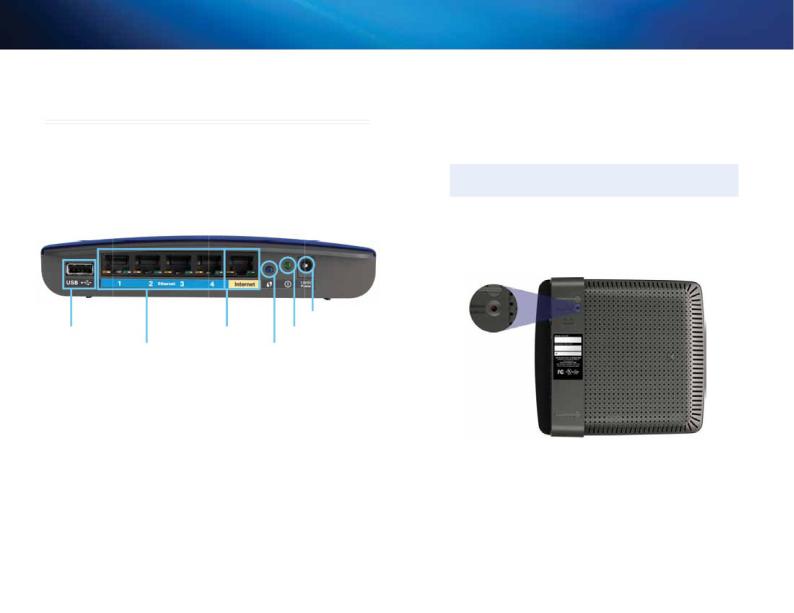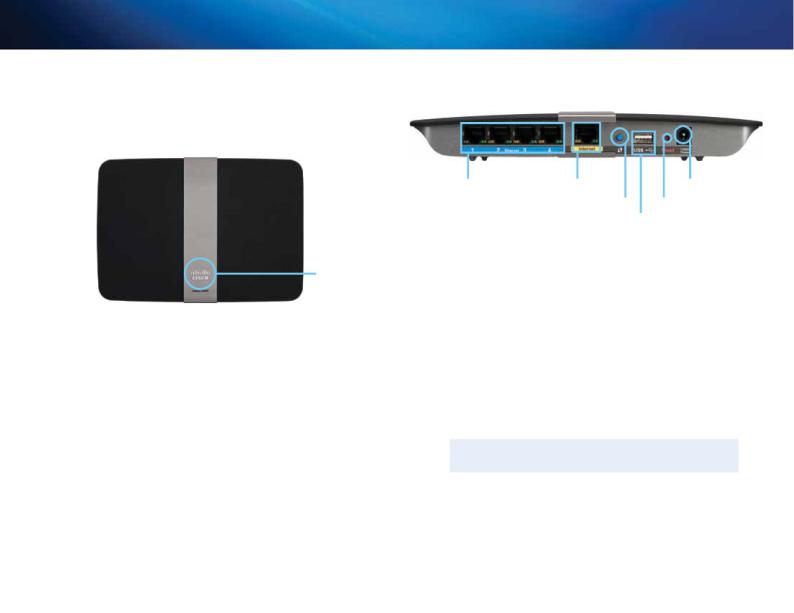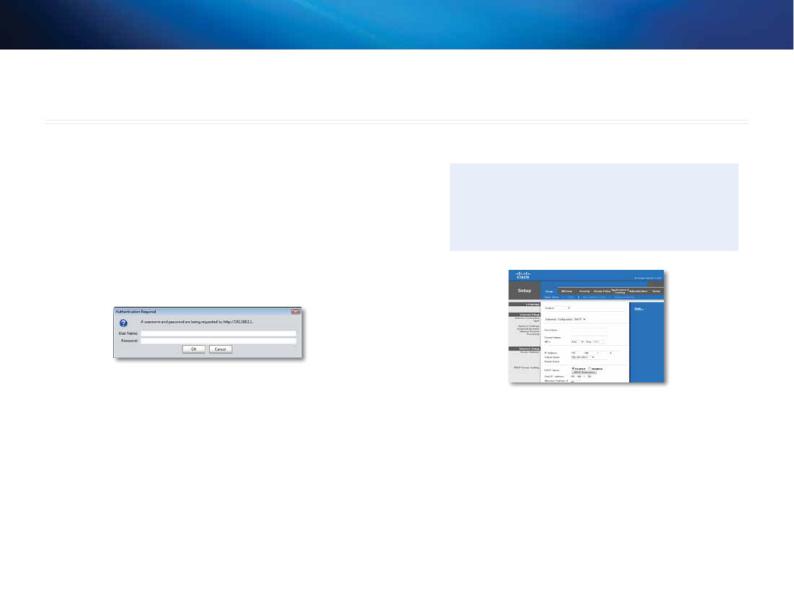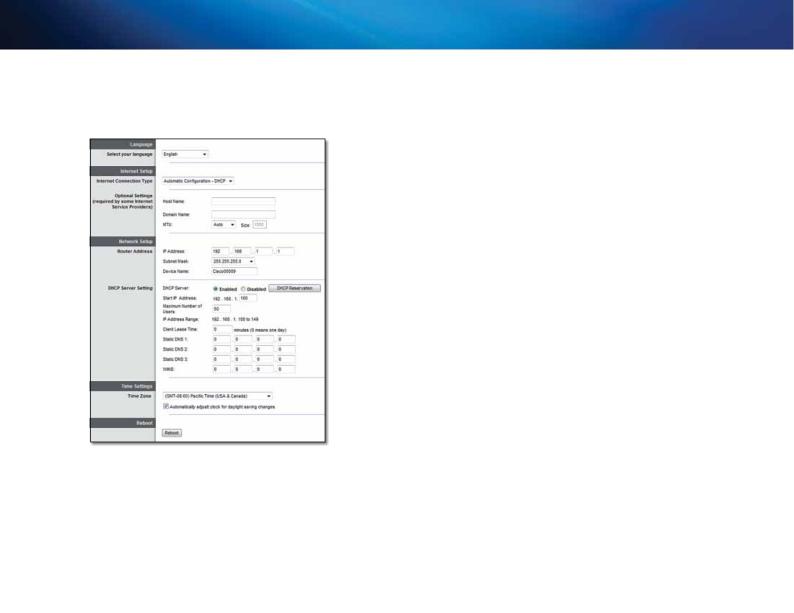LINKSYS EA3500 User Manual

Linksys E-Series Routers

Linksys E-Series
Table of Contents
Product overview
E1200/E1500/E2500/E3500 |
1 |
Back view |
1 |
Bottom view |
1 |
E4200 |
2 |
Top view |
2 |
Back view |
2 |
Setting Up Your E-Series Router
Where to find more help |
3 |
How to set up your router |
3 |
How to start Cisco Connect |
3 |
Use Cisco Connect to manage your router |
3 |
How to manually set up your router |
3 |
Advanced Configuration
How to open the browser-based utility |
4 |
Setup > Basic Setup |
5 |
Language |
5 |
Internet Setup |
5 |
Wireless > Basic Wireless Settings |
6 |
Wireless Settings |
6 |
Table of Contents
Wireless Security
Wireless > Wireless Security |
8 |
Personal options |
8 |
Office options |
8 |
Option settings |
8 |
Troubleshooting
How to run Cisco Connect after setup |
11 |
Your router was not successfully set up |
12 |
Get Windows XP Service Pack 3 message |
12 |
Your Internet cable is not plugged in message |
13 |
Cannot access your router message |
14 |
Device not found message |
15 |
Specifications
Linksys E1200 |
17 |
Linksys E1500 |
18 |
Linksys E2500 |
19 |
Linksys E3500 |
20 |
Linksys E4200 |
21 |
i

Linksys E-Series
Product overview
E1200/E1500/E2500/E3500
Back view
|
|
Power port |
USB port (E3500 only) |
Internet port |
Power indicator |
Ethernet ports |
Wi-Fi Protected Setup button |
|
Your router’s appearance may vary
•USB port (E3500 only)—To easily share disk storage with other users on your network or on the Internet, connect a USB drive to this port
•Ethernet ports—Connect Ethernet cables (also called network
cables) to these Fast Ethernet (10/100, for E1200 and E1500) or Gigabit (10/100/1000, for E2500 and E3500) ports, color coded blue, and to other wired Ethernet network devices on your network
•Internet port—Connect an Ethernet cable (also called a network or Internet cable) to this port, color coded yellow, and to your modem
Wi-Fi Protected Setup™ button—Press this button to easily configure wireless security on Wi-Fi Protected Setup-enabled network devices For more information, see “Wireless Security” on page 8
Product overview
•Power indicator—Stays on steadily while power is connected and following a successful Wi-Fi Protected Setup connection Flashes slowly during bootup, during firmware upgrades, and during a Wi-Fi Protected Setup connection Flashes quickly when there is a Wi-Fi Protected Setup error
•Power—Connect the included AC power adapter to this port
CAUTION
Use only the adapter that came with your router
•Power button—Press | (on) to turn on the router
Bottom view
Your router’s appearance may vary
•Reset button—Press and hold this button for 5-10 seconds (until the
port lights flash at the same time) to reset the router to its factory defaults You can also restore the defaults using the browser-based utility
1

Linksys E-Series
E4200
Top view
Indicator light
•Indicator light—Stays on steadily while power is connected and following a successful Wi-Fi Protected Setup connection Pulses slowly during bootup, during firmware upgrades, and during a Wi-Fi Protected Setup connection Flashes quickly when there is a Wi-Fi Protected Setup error
Product overview
Back view
Ethernet ports |
Internet port |
Power port |
|
Wi-Fi Protected Setup button |
Reset button |
|
USB port |
|
•Ethernet ports—Connect Ethernet cables (also called network cables) to these Gigabit (10/100/1000) ports, color coded blue, and to other wired Ethernet network devices on your network
•Internet port—Connect an Ethernet cable (also called a network or Internet cable) to this port, color coded yellow, and to your modem
•Wi-Fi Protected Setup™ button—Press this button to easily configure wireless security on Wi-Fi Protected Setup-enabled network devices For more information, see “Wireless Security” on page 8
•USB port—To easily share disk storage with other users on your network or on the Internet, connect a USB drive to this port
•Reset button—Press and hold this button for 5-10 seconds (until the
port lights flash at the same time) to reset the router to its factory defaults You can also restore the defaults using the browser-based utility
•Power—Connect the included AC power adapter to this port
CAUTION
Use only the adapter that came with your router
•Power button—Press | (on) to turn on the router
2

Linksys E-Series
Setting Up Your E-Series Router
Where to find more help
In addition to this User Guide, you can find help at these locations:
•Linksys.com/support (documentation, downloads, FAQs, technical support, live chat, forums)
•Cisco Connect help (run Cisco Connect, then click Learn More where available)
•Browser-based utility context-sensitive help (open the utility, then click Help in the right-side column )
How to set up your router
The easiest and fastest way to set up your router is to run the Cisco Connect setup software
How to start Cisco Connect
When you run the setup CD, Cisco Connect (your router’s setup software) is automatically installed onto your computer You can then use Cisco Connect to easily manage your router
NOTE:
If you lose your setup CD, you can download the software from Linksys.com/support
Setting Up Your E-Series Router
To start Cisco Connect for the first time:
1 . Insert the CD into your CD or DVD drive
2 . Click Set up your Linksys Router
If you do not see this:
•For Windows, click Start, Computer, then double-click the CD drive and the Setup icon
•For Mac, double-click the CD icon on your desktop, then double-click the Setup icon
3 . Follow the on-screen instructions to complete your router setup
Use Cisco Connect to manage your router
After your router has been set up and Cisco Connect has been installed, you can use Cisco Connect to easily manage many of your router’s settings such as:
•Connect devices to your network
•Test your Internet connection speed
•Configure parental controls
•Set up guest access
•Change your router’s name and password
How to manually set up your router
After setting up the router with the setup software (located on the CD), the router will be ready for use If you would like to change its advanced settings, or if the software does not run, use the router’s browser-based utility You can access the utility with a web browser on a computer connected to the router For more information on using the utility, see “How to open the browser-based utility” on page 4
3

Linksys E-Series
Advanced Configuration
How to open the browser-based utility
To access some advanced settings, you need to open the browser-based utility
To open the browser-based utility:
1 . Run Cisco Connect, click Change under Router settings, click Advanced settings, then click oK
– or –
Open a web browser on a computer connected to your network, then go to 192.168.1.1
The router prompts you for a user name and password
Advanced Configuration
2 . Enter the user name and password, then click oK The utility’s main menu opens
TIPS
If you set up your router without using Cisco Connect, your router’s default password is admin (You can leave the user name blank )
If you used Cisco Connect to set up your router, you can see your router’s user name and password by running Cisco Connect, then clicking Router settings
4

Linksys E-Series
Setup > Basic Setup
The first screen that appears is the Basic Setup screen This allows you to change the router’s general settings
Advanced Configuration
Language
Select your language To use a different language, select one from the dropdown menu The language of the browser-based utility will change five seconds after you select another language
Internet Setup
The Internet Setup section configures the router to your Internet connection Most of this information can be obtained through your Internet Service Provider (ISP)
Internet Connection Type
Select the type of Internet connection your ISP provides from the drop-down menu The available types are:
•Automatic Configuration - DHCP
•Static IP
•PPPoE
•PPTP
•L2TP
•Telstra Cable
Automatic Configuration - DHCP
The default Internet Connection Type is Automatic Configuration - DHCP (Dynamic Host Configuration Protocol) Keep the default only if your ISP supports DHCP or if you connect using a dynamic IP address (This option usually applies to cable connections )
Static IP
If you are required to use a fixed IP address to connect to the Internet, select Static IP
PPPoE
If you have a DSL connection, check whether your ISP uses Point-to-Point Protocol over Ethernet (PPPoE) If so, select PPPoE
5

Linksys E-Series
PPTP
Point-to-Point Tunneling Protocol (PPTP) is a service that generally applies to connections in Europe If your PPTP connection supports DHCP or a dynamic IP address, then select obtain an IP Address Automatically If you are required
to use a fixed IP address to connect to the Internet, then select Specify an IP Address and configure the options below
L2TP
Layer 2 Tunneling Protocol (L2TP) is a service that generally applies to connections in Israel
Telstra Cable
Telstra Cable is a service that generally applies to connections in Australia
Connect on Demand or Keep Alive
The Connect on Demand and Keep Alive options let you choose whether the router connects to the Internet only as needed (useful if your ISP charges for connect time), or if the router should always be connected Select the appropriate option
Advanced Configuration
Wireless > Basic Wireless Settings
The basic settings for wireless networking are set on this screen
NOTE
After you set up the wireless network(s), set up the wireless security settings
Wireless Settings
network Mode Select the wireless standards your network will support
•Mixed If you have Wireless-N (2 4 GHz), Wireless-G, and Wireless-B devices in your network, keep the default, Mixed
•Wireless-B/G only If you have both Wireless-B and Wireless-G (2 4 GHz) devices in your network, select Wireless-B/G only
•Wireless-B only If you have only Wireless-B devices, select Wireless-B only
•Wireless-G only If you have only Wireless-G devices, select Wireless-G only
•Wireless-n only If you have only Wireless-N (2 4 GHz) devices, select Wireless-n only
•Disabled If you have no Wireless-B, Wireless-G, and Wireless-N (2 4 GHz) devices in your network, select Disabled
NOTE
If you have a dual-band router, you can select Mixed, Wireless-A
Only, Wireless-N Only, or Disabled for the 5 GHz band
If you are not sure which mode to use, keep the default, Mixed
6
